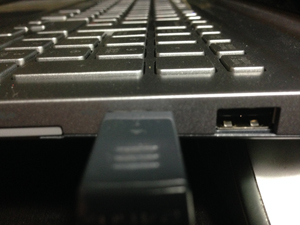What Is This? Windows Basics
3. Peripherals
3.1. Other Peripherals
 This image shows two USB entry ports on the side of a laptop (one of them has a wireless mouse connector inserted). The USB port connects most modern peripherals to your computer.
This image shows two USB entry ports on the side of a laptop (one of them has a wireless mouse connector inserted). The USB port connects most modern peripherals to your computer.
There are usually several ports on a computer and they can be on the front, the sides or the back of the computer case. When you insert a device into the port, your computer will automatically recognize it and ask you what you want to do next.
It is generally preferable to transfer or share files via the Internet (discussed in Unit 3) but there may be times when it will be more convenient and secure to save data on to a portable USB flash drive (also called a memory stick, keydrive or thumbdrive).
When the USB flash drive is inserted into your computer, follow the instructions on your computer screen and select open files on this device. 
You can usually drag files back and forth between your computer folders and the usb folders. Sometimes the USB flash drive is password protected. To prevent possible data loss, close the files on the USB flash drive before removing it from the computer.
Older computers may have an opening for inserting and playing a cd or dvd but most new computers no longer contain this option.